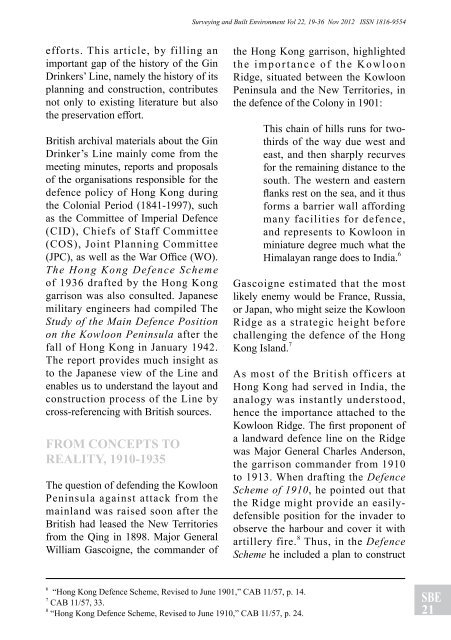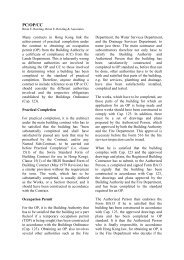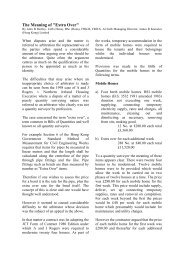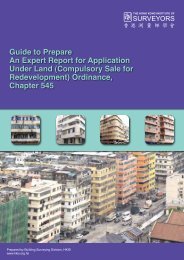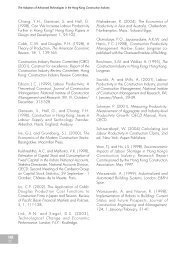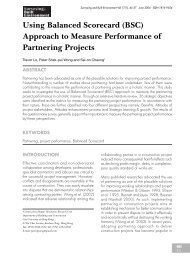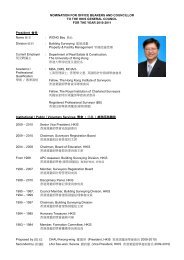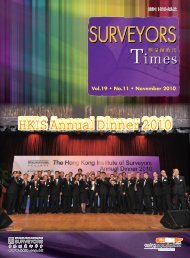Surveying & Built Environment Vol. 22 Issue 1 (December 2012)
Surveying & Built Environment Vol. 22 Issue 1 (December 2012)
Surveying & Built Environment Vol. 22 Issue 1 (December 2012)
Create successful ePaper yourself
Turn your PDF publications into a flip-book with our unique Google optimized e-Paper software.
efforts. This article, by filling an<br />
important gap of the history of the Gin<br />
Drinkers’ Line, namely the history of its<br />
planning and construction, contributes<br />
not only to existing literature but also<br />
the preservation effort.<br />
British archival materials about the Gin<br />
Drinker’s Line mainly come from the<br />
meeting minutes, reports and proposals<br />
of the organisations responsible for the<br />
defence policy of Hong Kong during<br />
the Colonial Period (1841-1997), such<br />
as the Committee of Imperial Defence<br />
(CID), Chiefs of Staff Committee<br />
(COS), Joint Planning Committee<br />
(JPC), as well as the War Office (WO).<br />
The Hong Kong Defence Scheme<br />
of 1936 drafted by the Hong Kong<br />
garrison was also consulted. Japanese<br />
military engineers had compiled The<br />
Study of the Main Defence Position<br />
on the Kowloon Peninsula after the<br />
fall of Hong Kong in January 1942.<br />
The report provides much insight as<br />
to the Japanese view of the Line and<br />
enables us to understand the layout and<br />
construction process of the Line by<br />
cross-referencing with British sources.<br />
fRoM CoNCEpTS To<br />
REAlITY, 1910-1935<br />
The question of defending the Kowloon<br />
Peninsula against attack from the<br />
mainland was raised soon after the<br />
British had leased the New Territories<br />
from the Qing in 1898. Major General<br />
William Gascoigne, the commander of<br />
<strong>Surveying</strong> and <strong>Built</strong> <strong>Environment</strong> <strong>Vol</strong> <strong>22</strong>, 19-36 Nov <strong>2012</strong> ISSN 1816-9554<br />
6<br />
“Hong Kong Defence Scheme, Revised to June 1901,” CAB 11/57, p. 14.<br />
7<br />
CAB 11/57, 33.<br />
8<br />
“Hong Kong Defence Scheme, Revised to June 1910,” CAB 11/57, p. 24.<br />
the Hong Kong garrison, highlighted<br />
the importance of the Kowloon<br />
Ridge, situated between the Kowloon<br />
Peninsula and the New Territories, in<br />
the defence of the Colony in 1901:<br />
This chain of hills runs for twothirds<br />
of the way due west and<br />
east, and then sharply recurves<br />
for the remaining distance to the<br />
south. The western and eastern<br />
flanks rest on the sea, and it thus<br />
forms a barrier wall affording<br />
many facilities for defence,<br />
and represents to Kowloon in<br />
miniature degree much what the<br />
Himalayan range does to India. 6<br />
Gascoigne estimated that the most<br />
likely enemy would be France, Russia,<br />
or Japan, who might seize the Kowloon<br />
Ridge as a strategic height before<br />
challenging the defence of the Hong<br />
Kong Island. 7<br />
As most of the British officers at<br />
Hong Kong had served in India, the<br />
analogy was instantly understood,<br />
hence the importance attached to the<br />
Kowloon Ridge. The first proponent of<br />
a landward defence line on the Ridge<br />
was Major General Charles Anderson,<br />
the garrison commander from 1910<br />
to 1913. When drafting the Defence<br />
Scheme of 1910, he pointed out that<br />
the Ridge might provide an easilydefensible<br />
position for the invader to<br />
observe the harbour and cover it with<br />
artillery fire. 8 Thus, in the Defence<br />
Scheme he included a plan to construct<br />
SBE<br />
21


